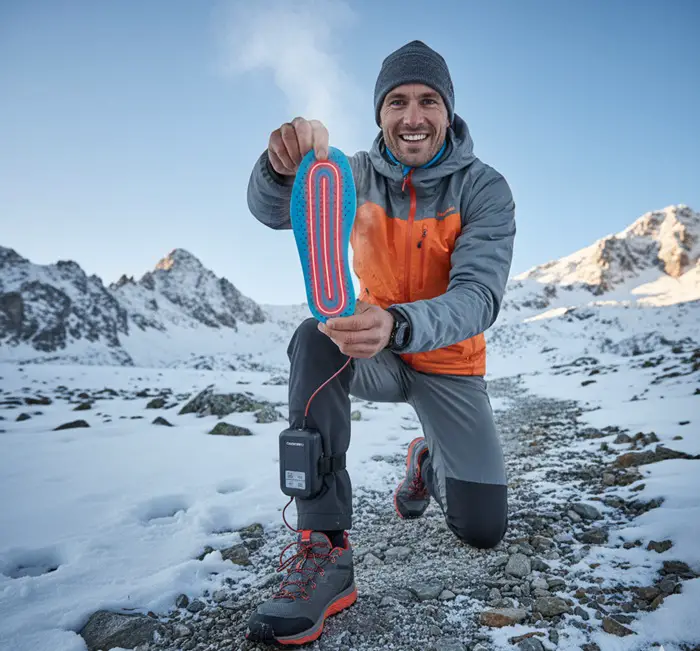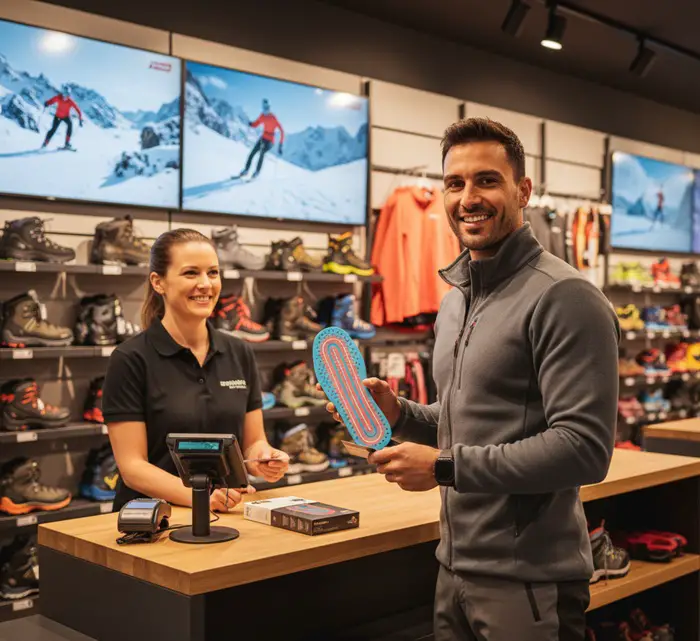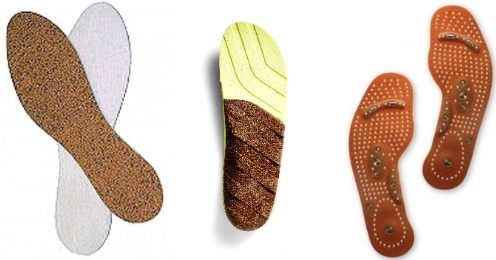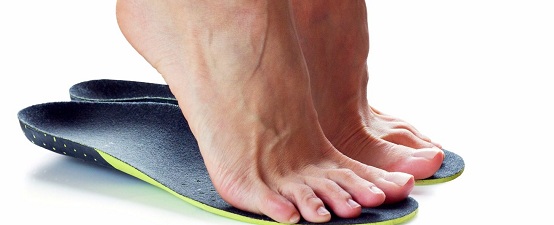
It’s coming up to the time of year again when people stock up on the marshmallows and hot chocolate, wrap up warm, dust off their skiing and hiking equipment, and head off to the slopes to enjoy all that the great outdoors has to offer.
Skiing breaks and hiking breaks are now more popular than ever, and if you’re thinking of heading outdoors and trying your hand at either/both, one of the most important things you’ll need to be is to stay warm.
Electric heated socks and heated insoles are incredibly popular this time of year, and during the holidays, they make truly wonderful stocking fillers.
But what’s the difference between them, and which one should you pick for your needs? Let’s discuss right here…
What are Heated Socks?
Electric heated socks, or battery-powered heated socks, as they are sometimes called, are specially designed socks that have been created to keep the wearer’s feet warm in cooler weather.
They’re designed with heating elements that provide far-infrared rays and deep penetrating heat.
These socks are electronically operated to heat up and provide continuous heat when switched on.
Depending on your chosen brand, these socks provide anything from 2 hours up to 14 hours of continuous heating.
Pros:
- Warm the feet faster
- It can be used with different boots
- It can be controlled with your smartphone
- It can be recharged easily with a rechargeable battery pack
Cons:
- Bulky to carry
- It can be expensive to buy
What are Heated Insoles?
Like the battery-operated socks, heated insoles are also meant to relieve your cold feet in that below-freezing temperature.
These are designed to keep your feet at a consistent temperature without getting too sweaty due to heat.
The working procedure of these heated insoles can differ based on the brand and model you purchase.
However, the basic idea will be the same for all of them, which is to keep your feet warm by providing them with artificial heat.
Pros:
- Lightweight
- Comes at a lower cost
- It can be used as an insole for better fitting
- It can be recharged easily via USB, Motorcycle’s battery
Cons:
- Does not warm the feet much
- It cannot be used with different boots
- Limited options to control the temperature

Heated Socks vs. Heated Insoles: Which is Better?
If you’ve got a ski trip on your calendar, or maybe a hiking, running, or hunting adventure with friends this fall or winter, then you already know one thing: cold feet can ruin the entire experience.
That’s why many outdoor lovers swear by heated socks or heated insoles. But when it comes down to choosing between the two, things can get a little confusing.
I’ve tested both, and while they’re designed to do the same job—keeping your feet warm—the way they work and feel can be very different.
Let’s break it down so you can choose the option that fits your needs best.
1. Fit and Ease of Use
Heated Insoles: Think of these like regular insoles, but with built-in heating elements. You slip them inside your boots once, and you’re set.
No pulling them on or off like socks. Most come with a remote control or app, so you can easily adjust the temperature (or turn them off) without taking your boots off.
Heated Socks: These are worn just like regular socks, but they come with heating wires running through the fabric. While they do provide direct warmth against your skin, you’ll have to remove them if you no longer need heat.
2. Bulk and Comfort
Heated Socks: Because of the wiring and battery pack (usually clipped near the calf), they can feel bulkier. When skiing or hiking long distances, that extra weight can sometimes get in the way.
Heated Insoles: Slimmer and less intrusive. Plus, they add cushioning and sometimes arch support, which can improve your boot fit. This can be a big win if your boots are slightly loose.
3. Versatility
Socks: You can wear heated socks with any pair of boots or shoes without worrying about the size or shape of the insole. This makes them more flexible if you plan on using multiple types of footwear.
Insoles: Once trimmed and fitted into a pair of boots, they usually stay there. You won’t be swapping them from one pair to another very often.
4. Durability
Socks: With regular washing, the heating wires can wear out over time. If you’re someone who uses them daily, expect a shorter lifespan unless you invest in premium models.
Insoles: Generally more durable since they don’t go through the wash cycle. However, their lifespan depends on how much hiking or skiing you do—constant heavy use can wear out the cushioning.
5. Cost and Value, and Power Options
Heated Socks: Usually range between $50–$150. A good pair can last a few seasons if cared for properly, and they’re perfect if you want direct skin warmth.
Heated Insoles: Typically a bit pricier, $100–$250 depending on features like remote control, Bluetooth, or custom fitting. They’re a great long-term investment if comfort and convenience matter most.
Both heated socks and heated insoles typically come battery-powered and USB-rechargeable.
Modern versions use lightweight lithium-ion batteries, which can last anywhere from 4 to 12 hours depending on the heat setting.
Some high-end insoles even come with wireless charging docks or Bluetooth connectivity for easy control.
So, which is better for you?
- For skiing or activities where you need snug-fitting boots, heated insoles are the clear winner. They improve fit, keep the warmth evenly distributed, and you don’t have to fuss with socks.
- For hiking, hunting, or situations where you may switch between different boots, heated socks give you more flexibility and direct warmth, though they can feel bulkier.
At the end of the day, it comes down to personal preference and how you plan to use them.
Personally, I like insoles for skiing trips (since boot fit is everything), but prefer socks for camping or casual winter hikes when I may change shoes often.
One thing’s certain—whichever you choose, your toes will thank you when the temperatures drop.
| Feature | Heated Insoles | Heated Socks |
|---|---|---|
| Fit | Slip inside boots; stay put | Worn directly on feet |
| Comfort | Slim, improves boot fit | Bulkier due to wires & battery |
| Warmth | Heats sole (bottom-up) | Heats whole foot & toes |
| Power | USB/battery, 4–12 hrs | USB/battery, 4–10 hrs |
| Washable | Not washable | Washable (gentle care needed) |
| Durability | 3–5 years (less wear/wash stress) | 1–3 years (washing reduces life) |
| Flexibility | Best for one pair of boots | Works with any footwear |
| Cost | Higher ($100–$250) | Moderate ($50–$150) |
| Best For | Skiing, snug boots, long trips | Hiking, hunting, everyday winter use |

Can You Wear Both Heated Insoles and Socks at the Same Time?
Technically, yes, you can layer heated insoles and heated socks if you’re heading into extreme cold.
But in snug ski or hiking boots, this combo can feel tight and uncomfortable.
Plus, managing two sets of batteries isn’t always practical. For most people, choosing one good-quality option is more than enough to stay warm and safe.
Irrespective of some cons, here’s why many users prefer to use heated socks or insoles (together) when skiing or hiking.
Keep Your Feet Warm – Cold feet aren’t just uncomfortable—they can actually be risky in snow or freezing weather (think frostbite or trench foot).
Heated socks and insoles make sure your toes stay cozy, whether you’re skiing down slopes or trekking through unpredictable trails.
Pure Comfort – Warm feet simply feel better. Instead of worrying about numb toes, you can focus on enjoying your adventure.
A little heat makes a huge difference in how enjoyable (or miserable) your day outdoors will be.
Extra Support – Many heated insoles add cushioning and improve boot fit, while heated socks can ease pressure and give light pain relief.
That extra support means less foot fatigue and more fun on the slopes or trails.
Better Circulation – Warmth naturally improves blood flow, which helps your feet stay healthier and reduces the risk of cold-related problems.
Good circulation = more warmth, more oxygen, and lower chances of frostbite.

Factors You Should Look For When Picking Heated Socks and Insoles
In this next section, we’re going to share a few useful tips with you on choosing the best electric heated socks and insoles.
No matter what you choose (electric heated socks or insoles), there are a few essential factors you will need to consider so that you end up buying the right pair for you.
1- Heating time:
You need to remember that not all electric heated insoles/socks are created equal.
Different manufacturers offer different devices, and as a result, some socks offer much longer heating durations than others.
If you’re planning on wearing your insoles and socks whilst hiking for several hours in the winter, you’ll want socks that provide long durations of heat.
When choosing electric heated socks or insoles, find out how long the insoles or socks you have your eyes on will provide continuous heat per charge.
As we mentioned earlier, some socks provide heat for around 2 hours per charge, whereas others will provide heat for as long as 14 hours per charge.
2- Material:
Another very important consideration when choosing electric heated socks is the material they’re made from.
Heated socks and insoles can come in various materials, so choose ones that feel right for you.
If you prefer thinner socks, look for thinner materials. If you want thicker materials, you can probably guess what we’ll tell you to look for.
3- Charge time:
For your socks/insoles to provide their heat, they need a lithium-ion battery. Batteries need to be charged up, so it’s important to consider the charge time.
If you need to charge them quickly, look for devices with shorter charge times.
Just bear in mind that socks can take upwards of 8 hours to fully charge in some instances, so if you do need them quickly, just make sure you don’t forget to stick them on charge as soon as you get to a power source.
4- Temperature control:
Some heated insoles and socks come complete with temperature control, so you can literally make them warmer or cooler.
You can use your smartphone for some devices and sync it wirelessly via Bluetooth, or alternatively, you can regulate the temperature via remote control.
If you would like the option of making your socks warmer or cooler, look for ones with temperature control.
5- Design:
Whilst your insoles or socks won’t really be visible, it still wouldn’t hurt to find ones in a design that you find attractive. This is especially true if you are picking the socks instead of insoles.
We understand that you’re not wearing them to make a fashion statement, but even so, choosing socks in a design that you find appealing is certainly not considered to be a bad thing.
Who Should Not Use Heated Socks and Insoles (Risks to Stay Aware of)
Heated gear is generally safe, but it isn’t for everyone. Here are situations where you should think twice before using them:
People with Poor Circulation or Nerve Damage – If you have conditions like diabetes, neuropathy, or Raynaud’s disease, you may not feel heat levels properly. This raises the risk of burns or unnoticed injuries for athletes and runners.
Those with Open Wounds, Blisters, or Skin Sensitivity – Direct heat against sensitive or injured skin can worsen the condition.
Pacemaker or Medical Device Users – While rare, some electric/battery-powered gear can interfere with certain implanted devices. Always check with your doctor first.
Children or Elderly with Limited Sensation – They may not notice if the socks/insoles get too hot or uncomfortable.
Anyone in Wet Conditions – Heated gear is electronic. Using it in very wet or submerged conditions can be unsafe and shorten product life.
Final Thoughts
At the end of the day, both heated socks and heated insoles are designed with one simple goal: to keep your feet warm so you can fully enjoy your time outdoors.
The “best” choice really depends on your activity and comfort preferences—insoles are fantastic for skiing and snug boots, while socks give you more flexibility across different footwear.
Whichever option you choose, remember that warmth isn’t just about comfort—it’s about safety too. Cold feet can cut your adventure short, or worse, lead to serious issues like frostbite.
Investing in a reliable pair of heated socks or insoles is less about luxury and more about making sure you can hike, ski, or hunt with confidence and peace of mind.
So, pick the one that fits your lifestyle, charge them up, and head out knowing your feet will stay warm, happy, and ready for adventure.




